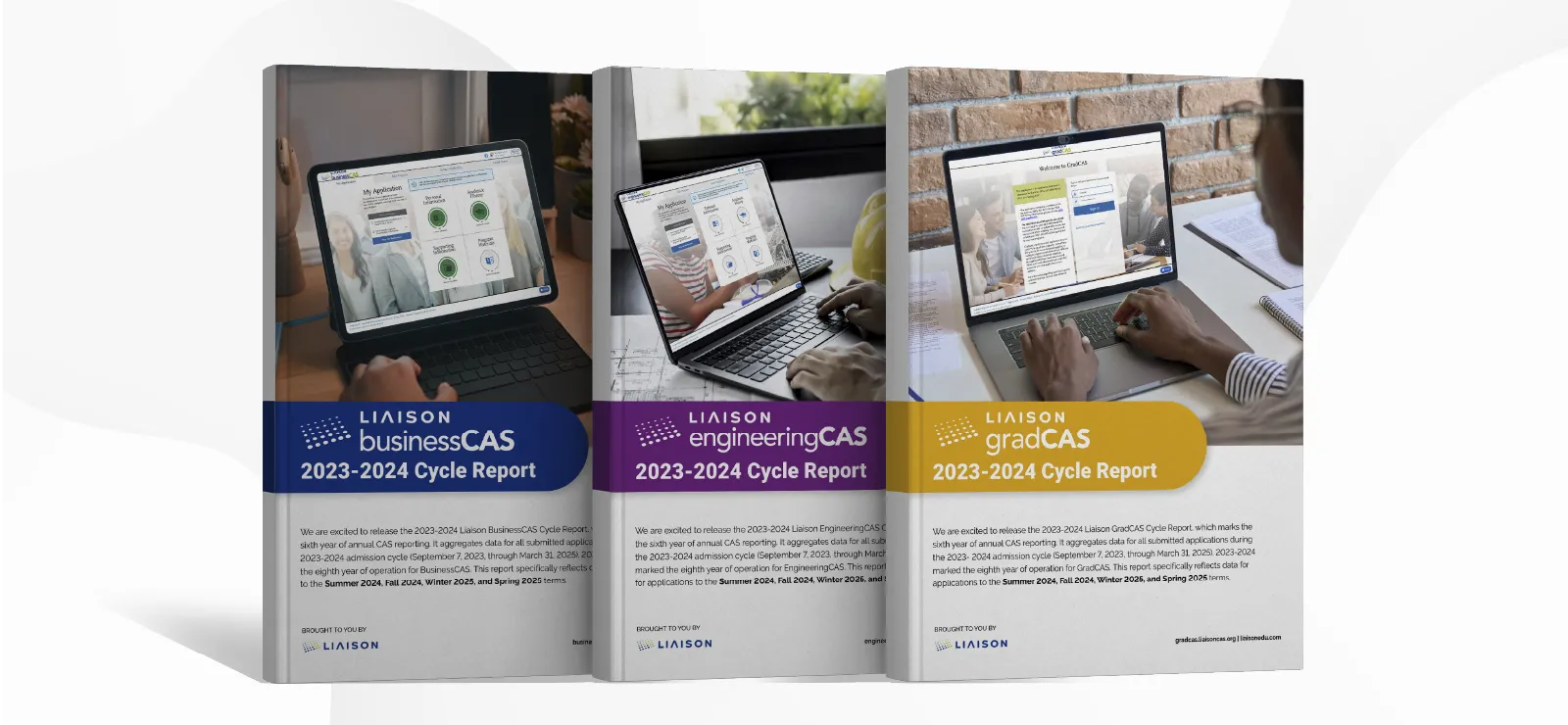What the Liaison CAS Cycle Reports Reveal About the 2023–24 Graduate Admissions Experience

The Cycle Reports are designed to spark better questions and inspire new ideas. By pairing your internal data with these insights, you’ll be better equipped to shape strategies that stick.
Key Takeaways
The new Liaison Centralized Application Service (CAS) Cycle Reports highlight data that shows trends in candidate profiles, program demand, and international students.
Each discipline-specific report surfaces enrollment trends you can use right away to sharpen your planning.
Applicants continue to rate the CAS experience highly for ease and efficiency, a reminder that application design directly shapes enrollment.
These insights give you a sharper benchmark against peers and a roadmap to refine recruitment and program design.
Every enrollment season tells a story, and the latest admissions cycle for business, engineering, and graduate programs participating in a Liaison Centralized Application Service (CAS) was no exception. Through the lens of Liaison’s new BusinessCAS, EngineeringCAS, and GradCAS 2023-2024 Cycle Reports, you’ll gain a rare opportunity to see how that story unfolded across the broader landscape. You’ll also uncover important insights into not only what changed but why those changes matter for future recruitment and program design initiatives.
The 2023–2024 Cycle Reports deliver a comprehensive look at applicant behavior and satisfaction, program trends, and institutional shifts. Whether you’re evaluating your own data or benchmarking against peer institutions, the findings help paint a clear picture of where graduate education is heading and what enrollment leaders should be preparing for.
Shifting Student Demographics and Enrollment Patterns
One of the most striking themes across the reports is the continued evolution of applicant demographics. Representation among students of color continues to grow in many disciplines, offering important signals about equity and access in graduate education. For example, students of color make up 68% of the BusinessCAS applicant pool, with a 4% increase in Black/African American applicants, while GradCAS programs saw a 2% increase of Black/African American applicants, who make up 20% of the applicant pool.
These changes present both opportunities and responsibilities for enrollment teams: How do you create environments where diverse students feel welcome, supported, and positioned for success?
At the same time, differences emerge between program areas. While some fields are seeing increased interest from historically underrepresented groups, others show stability or only modest change. Case in point: The number of applicants applying to engineering programs who identified as first-generation students decreased 2%, while the number increased 1% at business programs. Understanding where your discipline sits within this larger story can shape how you approach outreach, advising, and partnerships with other institutions.
Modality, Flexibility, and the Future of Programs
The shifting balance between onsite, hybrid, and flexible program formats emerged as another key theme. Graduate education as a whole continues to lean toward flexible and hybrid options, reflecting student demand for balance between career, family, and study. Business programs in particular highlight this trend, with part-time and online offerings becoming the norm rather than the exception.
Engineering programs, however, reveal a different pattern—onsite learning still plays an important role, likely because of the hands-on requirements that are harder to replicate virtually. These contrasting approaches remind us that one-size-fits-all solutions rarely apply in higher education. Enrollment leaders must consider what students say they want and what their fields require for true academic and professional preparation.
Expanding Global Reach
International interest in graduate study remains strong across the disciplines, with each CAS attracting applicants from all 50 U.S. states and more than 140 countries. It’s an important reminder that students from around the world have been continuing to seek opportunities in U.S. business, engineering, and graduate programs despite the uncertainty that some may be feeling.
This growth is encouraging, but it also comes with challenges. Beyond the ongoing need to refine credential evaluation processes, enhance communication strategies, and provide culturally responsive student support services, institutions are also navigating new realities shaped by shifting government policies. By benchmarking against national data, enrollment leaders can better understand how these external factors are influencing their global reach and determine whether more intentional, resource-savvy recruitment strategies are needed.
The Applicant Experience Matters
Finally, across all three reports, one message comes through loud and clear: The application process itself shapes perceptions of your institution, and ultimately, enrollment decisions. Applicants consistently rate application services like CAS as easier and more efficient than applying to individual programs one by one. The reports show that when institutions simplify the graduate admissions journey, they reduce barriers and create a stronger first impression for students.
Applicant satisfaction highlights:
- 89% of applicants surveyed found using EngineeringCAS much easier than completing separate applications.
- 88% of applicants surveyed found it much easier to use GradCAS rather than complete separate applications.
- 79% of applicants who used BusinessCAS are highly likely to recommend it.
This isn’t just a matter of convenience. A streamlined application signals that an institution respects a student’s time, understands their pressures, and values their experience from the very first interaction. In a competitive enrollment environment, that edge matters.
Turning Data Into Strategy
The strength of the CAS Cycle Reports lies in their ability to turn thousands of data points into usable insights. At the end of the day, data isn’t just about numbers, it’s about perspective. Having a clear, national benchmark helps leaders see whether their own trends are outliers or part of a larger pattern. That context can be the difference between reacting to short-term fluctuations and planning for long-term stability.
The Cycle Reports are designed to spark better questions and inspire new ideas. Where are we already ahead of the curve? Where do we need to rethink our approach? And how do these trends align with the unique mission of our institution? By pairing your internal data with these broader insights, you’ll be better equipped to shape strategies that stick.
Download the CAS reports today to see the complete findings and uncover insights that can directly inform your enrollment strategy for the upcoming cycle.












